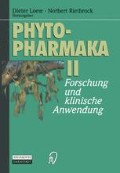Zusammenfassung
Die Entwicklung pharmakologisch aktiver Pflanzeninhaltsstoffe mit potentiell schädlichen Wirkungen ist im wesentlichen das Ergebnis der entwicklungsgeschichtlichen Kriegsführung zwischen autotrophen Pflanzen und den Tieren, die diese Pflanzen zur Deckung ihres Energiebedarfs fressen [8]. Die in der Evolution vorteilhaften Gegenmaßnahmen seitens der Konsumenten bestehen darin, wirksame Pflanzeninhaltsstoffe wie z.B. Flavonoide, Terpene, Steroide oder Alkaloide nicht zu resorbieren, sondern rasch renal oder biliär zu eliminieren oder in unwirksame Metaboliten zu überführen. Man kann somit annehmen, daß auch der menschliche Organismus eher darauf eingestellt ist, pflanzliche Wirkstoffe unwirksam zu machen, als synthetisch hergestellte Arzneistoffe mit anderen chemisch-physikalischen Eigenschaften zu eliminieren. Da der Gehalt der Wirkstoffe in pflanzlichen Nahrungsmitteln oft hoch ist — beispielsweise nimmt der Mensch am Tag bei normaler Ernährung bis zu 1 g Flavonoide auf [2] —, muß man annehmen, daß die Schutzmechanismen eine große Kapazität aufweisen. Es überrascht daher nicht, daß die biologische Verfügbarkeit von pharmakologisch aktiven Substanzen aus Phytopharmaka bei oraler Einnahme in vielen Fällen problematisch ist. Dagegen wird die Aufnahme anderer Pflanzeninhaltsstoffe wie Vitamine oder Nährstoffe, die fur den Konsumenten vorteilhaft oder sogar essentiell ist, oft durch aktive Prozesse unterstützt.
Access this chapter
Tax calculation will be finalised at checkout
Purchases are for personal use only
Preview
Unable to display preview. Download preview PDF.
Literatur
Bailey DG, Arnold JMO, Spence D (1994) Grapefruit juice and drugs. How significant is the interaction? Clin Pharmacokinet 26: 91–98
Bertram B (1989) Flavonoide–Eine Klasse von Pflanzeninhaltsstoffen mit vielseitigen biologischen Wirkungen, auch mit karzinogener Wirkung? Deutsche Apotheker-Zeitung 47: 2561–2571
Crespi CL, Code EL, Penman BW, Waxman DJ (1995) An activity-based method for integrating metabolism data from cDNA-expressed cytochrome P450 enzymes to the balance of enzymes in human liver microsomes. In: 9th International Conference on Cytochrome P450: Biochemistry, Biophysics and Molecular Biology, Book of Abstracts. Zürich, P 47
Fuhr U, Klittich K, Staib AH (1993) Inhibitory effect of grapefruit juice and the active component naringenin on CYP1A2 dependent metabolism of caffeine in man. Br J Clin Pharmacol: 35: 431–436
Fuhr U, Strobl G, Manaut F, Anders E-M, Sörgel F, Lopez-de-Brifas E, Chu DTW, Pernet AG, Mahr G, Sanz F, Staib AH (1993) Quinolone antibacterial agents: Relationship between structure and in vitro inhibition of the human cytochrome P450 isoform CYP1A2. Mol Pharmacol 43: 191–199
Fuhr U, Kummert A (1995) The fate of naringin in man- A key to grapefruit juice-drug interactions? Clin Pharmacol Ther 58: 365–373
Fuhr U, Weiss M, Kroemer HK, Neugebauer G, Rameis H, Weber W, Woodcock BG (1996) Systematic screening for pharmacokinetic interactions during drug development. Int J Clin Pharmacol Ther 34: 139–151
Guengerich FP (1993) Cytochrome P450 enzymes. Am Scientist 81: 440–447
Kober S, Spahn-Langguth H, Kurz A, Zaigler M, Fuhr U, Mutschler E (1996) Triamterene hydroxylation in human liver microsomes is mediated by the cytochrome P450 isoform CYP1A2. Naunyn-Schmiedeberg’s Arch Pharmacol 353 Suppl: R157
Kroemer HK, Echizen H, Heidemann H, Eichelbaum M (1992) Predictability of the in vivo metabolism of verapamil from in vitro data: Contribution of individual metabolic pathways and stereoselective aspects. J Pharmacol Exp Ther 260: 1052–1057
Kroemer HK, Eichelbaum M (1995) „It’s the genes, stupid“. Molecular bases and clinical consequences of genetic cytochrome P450 2D6 polymorphism. Life Sciences 56: 2285–2298
Lindenbaum J, Rund DG, Butler VP, Tse-Eng D, Saha JR (1981) Inactivation of digoxin by the gut flora: reversal by antibiotic therapy. N Engl J Med 305: 789–794
Loomis WF (1988) Four billion years: An essay on the evolution of genes and organisms. Sinauer Associates, Inc., Sunderland, Massachusetts, P 286–305
Martínez C, Agúndez JAG, Olivera M, Martin R, Ladero JM, Benitez J (1995) Lung cancer and mutations at the polymorphic NAT2 gene locus. Pharmacogenetics 5: 207–214
Nelson DR, Koymans L, Kamataki T, Stegeman JJ, Feyereisen R, Waxman DJ, Waterman MR, Gotoh O, Coon MJ, Estabrook RW, Gunsalus IC, Nebert DW (1996) P450 superfamily: update on new sequences, gene mapping, accession numbers and nomenclature. Pharmacogenetics 6: 1–42
Nordin C, Bertilsson L (1995) Active hydroxymetabolites of antidepressants. Emphasis on E-10-hydroxynortriptyline. Clin Pharmacokinet 28: 26–40
Strobl GR, Kruedener S von, Stöckigt J, Guengerich FP, Wolff T (1993) Development of a pharmacophore for inhibition of human liver cytochrome P-450 2D6: Molecular modeling and inhibition studies. J Med Chem 36: 1136–1145
Moltke LL von, Greenblatt DJ, Duan SX, Harmatz JS, Shader RI (1994) In vitro prediction of the terfenadine-ketoconazole pharmacokinetic interaction. J Clin Pharmacol 34: 1222–1227
Author information
Authors and Affiliations
Editor information
Editors and Affiliations
Rights and permissions
Copyright information
© 1996 Dr. Dietrich Steinkopff Verlag, GmbH & Co. KG, Darmstadt
About this paper
Cite this paper
Fuhr, U. (1996). Metabolismus von Fremdstoffen. In: Loew, D., Rietbrock, N. (eds) Phytopharmaka II. Steinkopff. https://doi.org/10.1007/978-3-642-85436-1_1
Download citation
DOI: https://doi.org/10.1007/978-3-642-85436-1_1
Publisher Name: Steinkopff
Print ISBN: 978-3-642-85437-8
Online ISBN: 978-3-642-85436-1
eBook Packages: Springer Book Archive

